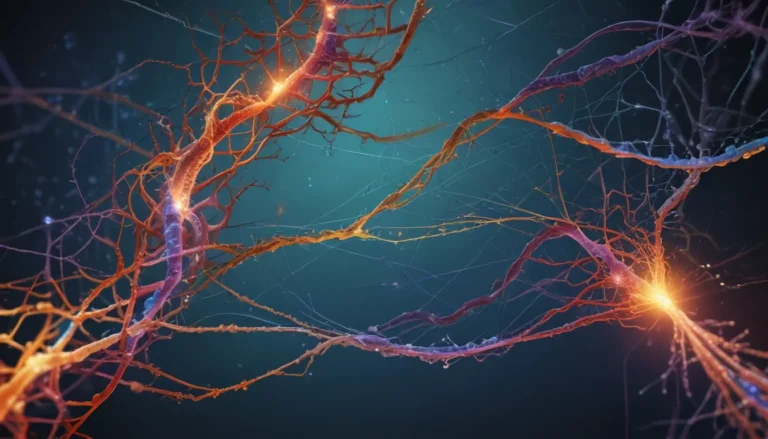A Note About Images: The images used in our articles are for illustration purposes only and may not exactly match the content. They are meant to engage readers, but the text should be relied upon for accurate information.
In the intricate realm of biological processes, signal termination stands out as a crucial phenomenon that governs cell communication and signaling pathways. By effectively switching off or dampening signals, cells can avoid continuous stimulation and maintain the delicate balance necessary for healthy functioning. Delving deep into the mechanisms of signal termination not only unravels the complexities of cellular processes but also holds the key to developing targeted therapies for a myriad of diseases. Join us on a captivating journey as we uncover 14 mind-blowing facts that shed light on the significance of signal termination in the world of biology.
Decoding Signal Termination: A Traffic Light for Cells
- Signal termination is akin to a traffic light for cells, ensuring precise and clear communication.
- It prevents cells from becoming desensitized to signals, akin to tuning out a repetitive sound.
- Understanding signal termination is instrumental in developing improved drugs and therapies for the benefit of overall health.
Ensuring Precision in Communication
When signals are transmitted between cells, signal termination plays a vital role in controlling the duration and intensity of communication. This precision allows for accurate information exchange, preventing any confusion or misinterpretation. It acts as a safeguard against the chaos that can arise from unchecked signaling.
The Role of G-protein Coupled Receptors (GPCRs)
- GPCRs are pivotal in signal termination, functioning as cell surface receptors that transmit signals from outside to inside the cell.
- Signal termination of GPCRs is facilitated through mechanisms like arrestin binding and receptor internalization, ensuring transient signaling cascades.
The Power of Protein Kinases
Protein kinases, as key enzymes in signal transduction pathways, regulate cellular signaling by phosphorylating target proteins. In signal termination, protein kinases play a critical role by inactivating or degrading receptors and downstream signaling molecules. Their actions contribute to the efficient cessation of signals.
Calcium Ions in Neuronal Synapses
- Calcium ions play a crucial role in signal termination within neuronal synapses.
- They are pumped out of the synaptic cleft after the transmission of an electrical impulse, facilitating the cessation of the signal and preventing continuous firing.
Preventing Desensitization Through Signal Termination
Signal termination mechanisms are essential in preventing desensitization, where cells become less responsive to a specific signal over time. By limiting the exposure to constant stimulation, signal termination ensures that cells retain their sensitivity to subsequent signals, maintaining effective communication.
Regulating Hormone Signaling
- Tight regulation of hormone signaling is achieved through signal termination mechanisms.
- Receptor internalization and degradation play a crucial role in controlling the duration and intensity of hormone signaling, preventing exaggerated or prolonged effects.
Modulating Immune Response
Signal termination is a key player in modulating immune responses by terminating signaling pathways involved in immune cell activation. This modulation enables the immune system to prevent excessive inflammation and maintain a balanced response.
Beyond Cell-to-Cell Communication
While signal termination is commonly associated with cell-to-cell communication, it also occurs within individual cells. Intracellular signaling pathways undergo signal termination to ensure the proper regulation of cellular processes, highlighting the multifaceted nature of this phenomenon.
Disruption by Genetic Mutations
- Genetic mutations can disrupt signal termination, leading to abnormal cellular responses.
- Such disruptions contribute to various diseases and disorders, underscoring the importance of intact signal termination mechanisms.
Essential for Neuronal Plasticity
Signal termination is critical for neuronal plasticity in the nervous system, enabling neurons to adapt and change in response to stimuli. This adaptability ensures proper neural development, learning, and memory formation, emphasizing the profound impact of signal termination on cognitive processes.
Influencing Drug Efficacy
Understanding signal termination mechanisms is pivotal in drug development, as researchers can target specific points in the termination process to enhance drug efficacy and reduce potential side effects. This targeted approach holds promise for optimizing therapeutic outcomes.
Modulation by External Factors
External factors such as environmental cues and stressors can influence signal termination processes, facilitating dynamic modulation. This adaptability allows organisms to respond to changing conditions and maintain homeostasis, showcasing the intricate interplay between internal and external factors.
A Tightly Regulated Process
Signal termination is intricately regulated through complex molecular mechanisms involving feedback loops, protein interactions, and post-translational modifications. These regulatory mechanisms work in harmony to ensure precise and efficient termination of signals, emphasizing the meticulous orchestration of cellular processes.
A Thriving Field of Research
Signal termination remains a vibrant area of research, with scientists continuously unraveling its complexities in various biological processes. Ongoing investigations aim to uncover novel insights into signal termination mechanisms and their implications in health and disease, promising exciting discoveries on the horizon.
These 14 captivating facts about signal termination illuminate its significance in biological systems, paving the way for advancements in medicine, therapeutics, and our comprehension of cellular communication. As researchers delve deeper into this intriguing field, anticipate groundbreaking discoveries that will revolutionize our understanding of cellular signaling and its implications for human health.
Conclusion: A Symphony of Signaling
In conclusion, signal termination emerges as a captivating process that underpins a myriad of biological functions. By orchestrating the termination of cellular signals, cells can fine-tune their responses and prevent aberrant activation, ensuring harmonious cellular communication. From inhibitory proteins to phosphatases, a symphony of mechanisms collaborates to terminate signals and uphold cellular homeostasis.
By unraveling the intricacies of signal termination, scientists can unlock new avenues for therapeutic interventions and gain profound insights into the workings of the human body. The evolving field of signal termination holds the promise of shedding light on novel mechanisms and their relevance to diseases such as cancer and neurodegenerative disorders, offering hope for innovative treatments and improved health outcomes.
FAQs: Unveiling Signal Termination
-
Q: What is signal termination?
A: Signal termination refers to the deactivation of cellular signaling pathways to maintain homeostasis and prevent excessive signal activation. -
Q: Why is signal termination important?
A: Signal termination is crucial for ensuring appropriate cellular responses and preventing abnormal behaviors and physiological dysregulation. -
Q: What mechanisms are involved in signal termination?
A: Inhibitory proteins, receptor desensitization, downregulation of signaling molecules, and dephosphorylation of key enzymes contribute to signal termination. -
Q: How does signal termination affect disease states?
A: Dysregulation of signal termination processes can contribute to diseases by causing uncontrolled cellular behaviors, such as tumor formation. -
Q: Are there drugs targeting signal termination mechanisms?
A: Yes, researchers are exploring the development of drugs that modulate signal termination to manipulate aberrant signaling pathways in diseases. -
Q: Can signal termination be harnessed for therapeutic purposes?
A: Understanding signal termination mechanisms can potentially lead to the development of targeted therapies to restore normal signaling and improve disease outcomes.
Celebrating Signal Termination: A Journey of Discovery
The enthralling facts about signal termination ignite curiosity and inspire exploration into related topics. On World Telecommunications Day, delve into the fascinating history and impact of signal termination in our interconnected world. For those intrigued by the technical aspects, ValhallaDSP pushes boundaries with innovative signal processing techniques, offering a glimpse into the cutting edge of technology. Audiophiles seeking unparalleled sound quality can explore our curated list of the best digital-to-analog converters, transforming digital signals into immersive analog audio experiences.
Our Commitment to Quality
At the core of our mission lies a dedication to delivering reliable and engaging content that resonates with our audience. Each fact shared on our platform is contributed by real users, enriching our repository with diverse insights and information. To ensure the highest standards of accuracy and authenticity, our diligent editors meticulously review every submission, guaranteeing that the facts we present are not only captivating but also dependable. Trust in our commitment to quality as you embark on a journey of exploration and discovery with us.
In this rewritten article, we’ve explored the fascinating world of signal termination, uncovering its intricacies and profound impact on cellular communication. Through a friendly and informative tone, we’ve delved into the key concepts surrounding signal termination, providing valuable insights for readers interested in the wonders of biology and signaling pathways. Join us in celebrating the marvels of signal termination and the endless possibilities it holds for advancing science and medicine.





